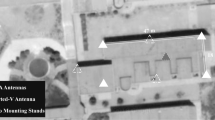Abstract
The MIRS microwave radiometer–spectrometer is described. The instrument is being developed using a conceptual design that was the first stage of ground preparations for the Convergence Space Experiment (SE). At the next stage of SE implementation, it is planned to use the proposed technical solutions as design documentation for manufacturing test and flight prototypes. MIRS is a multi-frequency scanner and sounder intended to record the characteristic radiothermal radiation emitted by the system of the Earth’s surface and atmosphere. The set of frequencies of the received radiation is in the range of 10 to 200 GHz. The device is to be installed on the Russian Orbital Segment (ROS) of the International Space Station (ISS). Conical scanning of the Earth’s surface is done by rotating an antenna unit mounted on a fixed base. With a 1.3 s period of rotation and a constant Earth incidence angle of 53.1 deg, continuous coverage of the Earth’s surface is ensured in a swath 800 km wide with spatial resolution of 10 km for the highest-frequency channels. Nine radiometer–polarimeters laid out as a full-power radiometer are used as radiation receivers. The MIRS antenna system is an offset parabolic antenna with separated irradiators. The optimum design solutions allowing the main problems of the SE to be solved and the MIRS parameters to be maintained under operating conditions on board the ISS are chosen for the conceptual design.






Similar content being viewed by others
REFERENCES
Khapin, Yu.B., Kuzmin, A.V., Semin, A.G., and Uteyev, A.V., On the limit characteristics of satellite radiometer–spectrometer in the range of 6–220 GHz, Sovrem. Probl. Distantsionnogo Zondirovaniya Zemli Kosmosa, 2013a, vol. 10, no. 3, pp. 150–159.
Khapin, Yu.B., Kuzmin, A.V., Semin, A.G., and Sharkov, E.A., Microwave radiometer–spectrometer with limit characteristics for the study of the Earth from space in the range of 6–220 GHz, Sovrem. Probl. Distantsionnogo Zondirovaniya Zemli Kosmosa, 2013b, vol. 10, no. 4, pp. 64–78.
Kutuza, B.G., Danilychev, M.V., and Yakovlev, O.I., Sputnikovyi monitoring Zemli: Mikrovolnovaya radiometriya atmosfery i poverkhnosti (Satellite Monitoring of the Earth: Microwave Radiometry of the Atmosphere and Surface), Moscow: LENAND, 2016.
Kuzmin, A.V., Pospelov, M.N., Khapin, Yu.B., and Sharkov, E.A., A new-generation microwave scanning radiometer–polarimeter), Sovrem. Probl. Distantsionnogo Zondirovaniya Zemli Kosmosa, 2005, vol. 1, pp. 238–243.
Lapshin, A.I., Kuzmin, A.V., Sadovskii, I.N., and Yurchuk, E.F., Onboard wide-aperture radiators for calibration of satellite microwave radiometers for remote sensing of the Earth, in 11-ya Vserossiiskaya nauchno–tekhn. konf. “Metrologiya v radioelektronike”: materialy konf. (Proceedings of the 11th All-Russian Scientific–Technical Conference “Metrology and Radio Electronics”), Moscow: VNIIFTRI, 2018, pp. 208–213.
Sharkov, E.A., Kuzmin, A.V., Vedenkin, N.N., Jeong, S., Ermakov, D.M., Kvitka, V.E., Kozlova, T.O., Komarova, N.Yu., Minaev, P.Yu., Park, Il.H., Pashinov, E.V., Pozanenko, A.S., Prasolov, V.O., Sadovskii, I.N., Sazonov, D.S., Sterlyadkin, V.V., Khapin, Yu.B., Hong, G., and Chernenko, A.M., Convergence space experiment: Scientific objectives, onboard equipment, and methods of solving inverse problems, Izv., Atmos. Ocean. Phys., 2019, vol. 55, no. 9, pp. 1437–1456.
Sterlyadkin, V.V. and Sharkov, E.A., Differential radiothermal methods for determining the vertical profile of water vapor in the Earth’s troposphere and stratosphere, Issled. Zemli Kosmosa, 2014, no. 5, pp. 15–28.
Sterlyadkin, V.V., Pashinov, E.V., Kuzmin, A.V., and Sharkov, E.A., Differential radiothermal methods for satellite retrieval of atmospheric humidity profile, Izv., Atmos. Ocean. Phys., 2017, vol. 53, no. 9, pp. 979–990.
ACKNOWLEDGMENTS
We thank N.Yu. Komarova for her assistance in documenting our work materials.
Funding
This work was performed as part of State Task no. 01.20.0.2.00164 (“Monitoring”); and by the Russian Foundation for Basic Research, project no. 18-02-01009-a.
Author information
Authors and Affiliations
Corresponding author
Additional information
Translated by M. Samokhina
Rights and permissions
About this article
Cite this article
Sadovsky, I.N., Kuzmin, A.V., Khapin, Y.B. et al. The MIRS Microwave Radiometer–Spectrometer as the Basis for the Convergence Space Experiment. Izv. Atmos. Ocean. Phys. 56, 1741–1750 (2020). https://doi.org/10.1134/S000143382012052X
Received:
Revised:
Accepted:
Published:
Issue Date:
DOI: https://doi.org/10.1134/S000143382012052X




